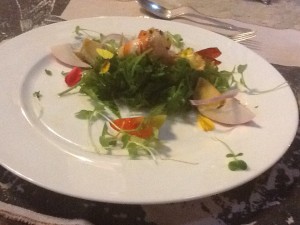 Taal: not just a volcano and a lake, but also a UNESCO heritage town in Calabarzon, overlooking Balayan Bay, about two hours south of Manila. Recently, I went on a fascinating expedition to Taal with food safari TourFlair.
Taal: not just a volcano and a lake, but also a UNESCO heritage town in Calabarzon, overlooking Balayan Bay, about two hours south of Manila. Recently, I went on a fascinating expedition to Taal with food safari TourFlair.
The drive took us past Mount Makiling, a legendary mountain in Laguna, apparently ideal for hiking. Mount Makiling is an inactive volcano, thickly forested and rising to 3,576 feet. The mountain was named for Maria Makiling, a mythical creature, ‘half nymph, half sylph, born under the moonbeams of Filipinas’.
Eventually, after a couple of wrong turns (I think we should invest in a GPS next time!) we arrived outside the Basilica of St Martin of Tours. Several small children greeted us with homemade lumps of candle for sale, while their elders pressed us with trays of nutty toffee biscuits. Dodging the vendors and the heat, we escaped into the cool cavern of the cathedral.
This grey stone basilica, like Manila Cathedral, has a checkered history. Originally 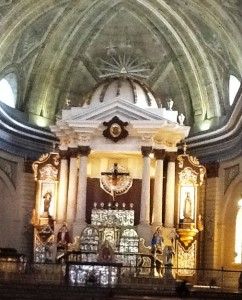 built on the edge of Lake Taal in 1575, the town and the church were abandoned in 1754 when Taal volcano erupted. Both were rebuilt further south, on a hill overlooking Balayan Bay. Although safe from the volcano, the church was nonetheless destroyed by an earthquake almost a century later. In 1856 it was once again resurrected by architect Luciano Olivero and consecrated in 1865. It has recently been beautifully restored, the walls and ceilings repainted in the original trompe l’oeil painting style that appears three dimensional. The Basilica de San Martin de Tours is reputedly the largest church in Asia, and its tabernacle is made of silver, a unique feature in the Philippines.
built on the edge of Lake Taal in 1575, the town and the church were abandoned in 1754 when Taal volcano erupted. Both were rebuilt further south, on a hill overlooking Balayan Bay. Although safe from the volcano, the church was nonetheless destroyed by an earthquake almost a century later. In 1856 it was once again resurrected by architect Luciano Olivero and consecrated in 1865. It has recently been beautifully restored, the walls and ceilings repainted in the original trompe l’oeil painting style that appears three dimensional. The Basilica de San Martin de Tours is reputedly the largest church in Asia, and its tabernacle is made of silver, a unique feature in the Philippines.
We were also invited to wander through the priests house, reached through a doorway in the south nave. What I remember most clearly is a huge open space and the widest, shiniest wooden floorboards I have ever seen. The view overlooking the square and the town to the sea was rather spectacular too. An old, deep water tank, open to the skies to collect the rain, has been cleaned out to create a home for a large collection of ornamental koi, framed by ferns growing from the walls.
Taal was also home to many revolutionary heroes such as the Agoncillo family. Marcella Agonicillo is now known as the ‘mother of the Philippine flag’. She was the principal seamstress to work on the first official Filipino flag, at the personal 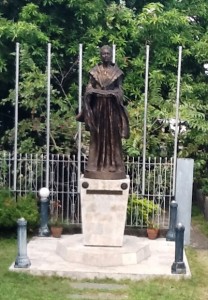 request from General Aguinaldo. Her bronze statue stands in the garden beside her eighteenth century ancestral home. It is a museum, a gracious old Spanish villa decorated with heavy antique furniture. Like the priests house, the floor boards – no longer cut this broadly – have been polished to a high shine over the centuries. We heaved ourselves up the steep, wooden staircase and admired the wide windows, framed with capiz shutters. Capiz shells are common in the Philippines and were chosen to create tiny window panes during the Spanish Colonial period. Cheaper than glass, capiz had the added bonus of allowing in the light while having the strength to withstand typhoons.
request from General Aguinaldo. Her bronze statue stands in the garden beside her eighteenth century ancestral home. It is a museum, a gracious old Spanish villa decorated with heavy antique furniture. Like the priests house, the floor boards – no longer cut this broadly – have been polished to a high shine over the centuries. We heaved ourselves up the steep, wooden staircase and admired the wide windows, framed with capiz shutters. Capiz shells are common in the Philippines and were chosen to create tiny window panes during the Spanish Colonial period. Cheaper than glass, capiz had the added bonus of allowing in the light while having the strength to withstand typhoons.
In a neighbouring colonial home we were offered welcome drinks before joining Sau de Rosario, TourFlair’s Signature Chef, on the back terrace overlooking the clear green river – a far cry from the Pasig! Here Sau had arranged a makeshift kitchen for a quick cooking demonstration. The ingredients had been prepared earlier, and were laid out on a large wooden table clothed in lengths of banana leaf. Armed with only a one ring cooker and a blender, we watched Sau whip up a delicious smoked fish pâté in moments. In case you would like to try this simple hors d’oeuvre, here is Sau’s recipe:
Cooking the Spanish (red) onion first, he then tossed in a handful of capers and added a couple of small bowls of smoked fish, a can of coconut cream and a sprinkling of dill. He stirred this over the heat only briefly – the fish is already cooked, so don’t overdo it, he told us –then spooned the mixture into the blender and reduced it to a creamy paste. It can then be poured into a bowl and refrigerated until ready to serve with fresh bread or rolls – Sau had made his own – and garnished with a sprig of dill and a nasturtium flower for a colourful canapé that is quite “Delish-oos!”
While Sau went off to prepare the rest of the lunch, we visited the Villa Tortuga, to 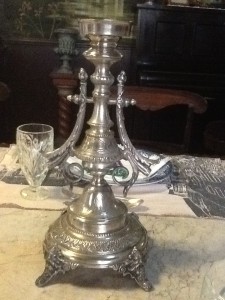 play dress-ups in eighteenth century Spanish colonial costumes, followed by a photo shoot. Most of the women joined in eagerly, fluttering like butterflies around the brightly coloured fabrics, picking through full, high-waisted skirts, cobweb-like shawls tied at the waist, lacy blouses and the stiff pena (pineapple) fabric – panuelo – fixed around the shoulders. Draping skirts and passing accessories to finish off the look, the photographers then posed each ‘Spanish lady’ before a painted backdrop, buzzing about as if for a fashion show. Parasols, fans, baskets of flowers, a vase of orchids, walking sticks and top hats were shared and exchanged and everyone looked magnificent, despite the heat. The gentlemen too, took a turn in barong tagalog and loose trousers, top hats and walking sticks. We even had a visit from a Cardinal!
play dress-ups in eighteenth century Spanish colonial costumes, followed by a photo shoot. Most of the women joined in eagerly, fluttering like butterflies around the brightly coloured fabrics, picking through full, high-waisted skirts, cobweb-like shawls tied at the waist, lacy blouses and the stiff pena (pineapple) fabric – panuelo – fixed around the shoulders. Draping skirts and passing accessories to finish off the look, the photographers then posed each ‘Spanish lady’ before a painted backdrop, buzzing about as if for a fashion show. Parasols, fans, baskets of flowers, a vase of orchids, walking sticks and top hats were shared and exchanged and everyone looked magnificent, despite the heat. The gentlemen too, took a turn in barong tagalog and loose trousers, top hats and walking sticks. We even had a visit from a Cardinal!
When everyone had posed for the photographers, we moved upstairs to a beautiful Spanish colonial dining room full of holy figurines and family portraits. Two long tables had been set for the five course lunch Sau had prepared for us.
We began with pumpkin flowers stuffed with cheese and lightly fried, tempura style, that were garnished with tomatillos, rucola and tiny, marble-sized tomatoes, and served with a light, tasty tomato chutney. Delicately flavoured, I could cheerfully have feasted on a bouquet of these moreish blooms.
Sau’s ubiquitous fiddlehead fern salad arrived next, served with large, meaty, pan-seared prawns marinated in coconut, a combination of textures that tickled the taste buds.
The soup was a traditional Pinoy bulalo, popular in Batangas and Tagaytay. It is usually made with beef shanks, but Sau had adapted the recipe to use chunks of corned beef and vegetables, over which the waiters poured a hot chicken broth. Sau described it as a bit like an Irish stew soup. It may not have reminded many of us of this thick, winter-warmer stew, but it was nonetheless a healthy and delicious concoction – even to someone highly suspicious of corned beef!
The chicken adobo had been marinated in vinegar. It was simply prepared, 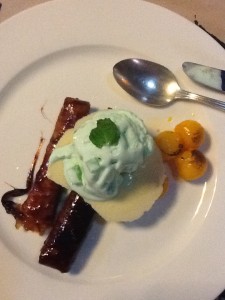 surprisingly tangy and filling, served with a ball of Spanish red rice. It pushed most of us to our limits in terms of stomach capacity, but it didn’t stop us enjoying dessert: a medley of green pistachio ice cream with coconut jelly, caramelized mango and rolls of leche flan filled with banana and coated in toffee resembling fried Spring rolls, sausages or cigars, the toffee effectively gluing our teeth together and giving us a dose of schoolgirl giggles that had nothing to do with the lunchtime rosé…
surprisingly tangy and filling, served with a ball of Spanish red rice. It pushed most of us to our limits in terms of stomach capacity, but it didn’t stop us enjoying dessert: a medley of green pistachio ice cream with coconut jelly, caramelized mango and rolls of leche flan filled with banana and coated in toffee resembling fried Spring rolls, sausages or cigars, the toffee effectively gluing our teeth together and giving us a dose of schoolgirl giggles that had nothing to do with the lunchtime rosé…
As always, TourFlair arranged a wonderful day of local culture, history and food, and we all went home wiser and well-fed.
*As published in April issue of British Women’s Association magazine

I would like to know what trips Tour Flair offers please. Do they have a website?
Indeed! http://www.tourflair.com